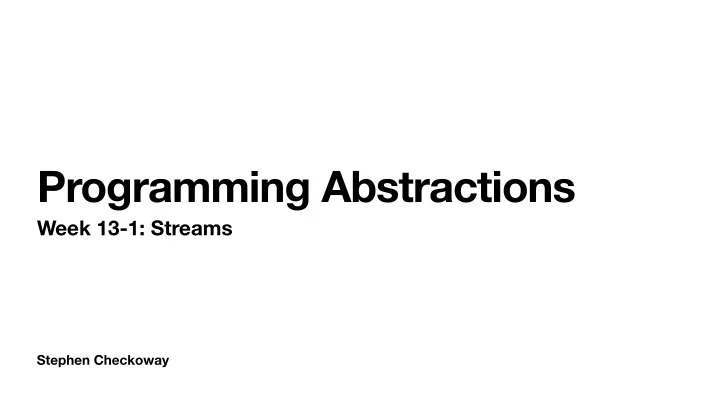

Programming Abstractions Week 13-1: Streams Stephen Checkoway
What is printed by this code? (let* ([x 10] [y x]) (set! x 20) (displayln y)) A. 10 B. 20 C. It's an error 2
What is printed by this code? (let* ([x 10] [y (delay x)]) (set! x 20) (displayln (force y))) A. 10 B. 20 C. It's an error 3
What is printed by this code? (let* ([x 10] [y (delay x)]) (set! x 20) (displayln (force y)) (set! x 30) (displayln (force y))) A. 20 C. 30 20 30 B. 20 D. It's an error 30 4
Last time: infinite list of primes First, we need to think about how we want to represent this Let's use a cons cell where ‣ the car is a prime; and ‣ the cdr is a promise which will return the next cons cell 2 #<promise> force 3 #<promise> force 5 #<promise>
An infinite list is an instance of a stream A stream is a (possibly infinite) sequence of elements A list is a valid, finite stream ‣ (stream? '(1 2 3)) => #t Infinite streams must be built lazily out of promises (using delay internally) Accessing elements of a stream force s their evaluation
Let's build a stream As with our infinite list of primes we'll use a cons-cell holding a value and a promise API ‣ (stream-cons head tail) ‣ (stream-first s) ‣ (stream-rest s) ‣ (stream-empty? s) ‣ empty-stream
Constructing a lazy stream (stream-cons head tail) We can't use a procedure because it'll evaluate head and tail (define-syntax stream-cons (syntax-rules () [(_ head tail) (delay (cons head (delay tail)))])) stream-cons returns a promise which when forced gives a cons cell where the second element is a promise
Accessing the stream (stream-first s) (stream-rest s) s is either a promise or a cons cell so we need to check which (define (stream-first s) (if (promise? s) (stream-first (force s)) (car s))) (define (stream-rest s) (if (promise? s) (stream-rest (force s)) (cdr s))) We can't use first and rest because those check if their arguments are lists
Checking if a stream is empty (define empty-stream null) (define (stream-empty? s) (if (promise? s) (stream-empty? (force s)) (null? s)))
Constructing an infinite stream Write a procedure which ‣ returns a stream constructed via stream-cons ‣ where the tail of the stream is a recursive call to the procedure Call the procedure with the initial argument (define (integers-from n) (stream-cons n (integers-from (add1 n)))) (define positive-integers (integers-from 0))
Accessing the elements We can use stream-first and stream-rest to iterate through the elements (define (stream-ref s idx) (cond [(zero? idx) (stream-first s)] [else (stream-ref (stream-rest s) (sub1 idx))]))
Primes as a stream (define (prime? n) …) ; Same as last time (define (next-prime n) (cond [(prime? n) (stream-cons n (next-prime (+ n 2)))] [else (next-prime (+ n 2))])) (define (primes) (stream-cons 2 (next-prime 3)))
Fibonacci numbers as a stream Recall the Fibonacci numbers are defined by f 0 = 0, f 1 = 1 and f n = f n -1 + f n -2 (define (next-fib m n) (stream-cons m (next-fib n (+ m n)))) (define fibs (next-fib 0 1))
Building streams from streams Let's write a procedure to add two streams together ‣ Use stream-cons to construct the new stream ‣ Use stream-first on each stream to get the heads ‣ Recurse on the tails via stream-rest (define (stream-add s t) (cond [(stream-empty? s) empty-stream] [(stream-empty? t) empty-stream] [else (stream-cons (+ (stream-first s) (stream-first t)) (stream-add (stream-rest s) (stream-rest t)))]))
Fibonacci numbers as a stream: take 2 f 0 = 0, f 1 = 1 and f n = f n -1 + f n -2 We can build our Fibonacci sequence directly from that definition (this is silly) (define fibs (stream-cons 0 (stream-cons 1 (stream-add fibs (stream-rest fibs)))))
Streams in Racket These are already built-in so we don't need to write them ‣ (require racket/stream) ‣ (stream exp ...) ; Works like (list exp ...) ‣ (stream? v) ‣ (stream-cons head tail) ‣ (stream-first s) ‣ (stream-rest s) ‣ (stream-empty? s) ‣ empty-stream ‣ (stream-ref s idx) And several others
Let's write some Racket! Open up a new file in DrRacket Make sure the top of the file contains #lang racket (require racket/stream) Write the procedure (stream-length s) which returns the length of a finite stream I.e., (stream-length (stream 1 2 3 4 5)) returns 5 Use stream-empty? and stream-rest
Write more stream procedures Write the procedure (stream->list s) that takes a finite-length stream and returns the elements as a list Write the following procedures that act like their list counterparts, but operate lazily on streams; in particular, do not cover them to lists! ‣ (stream-take s num) Returns a stream containing the first num elements of s , make sure this is lazy ‣ (stream-drop s num) Returns a stream containing all of the elements of s in order except for the first num ‣ (stream-filter f s) Returns a stream containing the elements x of s for which (f x) returns true ‣ (stream-map f s) Returns a stream by mapping f over each element of s
Multi-argument stream-map (stream-map f s ...) Racket has stream-map built-in but unlike its list counterparts, it only takes a single stream Generalize it to take any number of streams where the length of the returned string is the minimum length of any of the stream arguments (i.e., return empty- stream if any of the streams becomes empty); you'll want to use ormap , map and apply ‣ (define (stream-map f . ss) …)
Recommend
More recommend